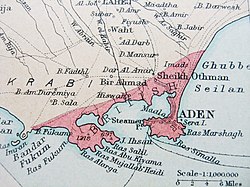
Back مستعمرة عدن Arabic Аден (колония) Bulgarian Colònia d'Aden Catalan Adenská kolonie Czech Kolonie Aden German Kolonio Adeno Esperanto Colonia de Adén Spanish مستعمره عدن Persian Adenin siirtomaa Finnish Colonie d'Aden French
Aden Colony مُسْتْعَمَرَةْ عَدَنْ | |||||||||
|---|---|---|---|---|---|---|---|---|---|
| 1937–1963 | |||||||||
Anthem:
| |||||||||
 Map of Aden Colony and its dependencies in red | |||||||||
 Map of Aden Colony | |||||||||
| Status | Crown colony of the United Kingdom | ||||||||
| Capital | Aden 12°48′N 45°02′E / 12.800°N 45.033°E | ||||||||
| Common languages | |||||||||
| Demonym(s) | Adenese | ||||||||
| Government | Constitutional monarchy | ||||||||
| Monarch | |||||||||
• 1937–1952 | George VI | ||||||||
• 1952–1963 | Elizabeth II | ||||||||
| Governor | |||||||||
• 1937–1940 | Sir Bernard Reilly | ||||||||
• 1960–1963 | Sir Charles Johnston | ||||||||
| Legislature | Legislative Council | ||||||||
| History | |||||||||
• Aden Settlement established | 1839 | ||||||||
• Aden Colony established | 1937 | ||||||||
• State of Aden established | 18 January 1963 | ||||||||
• State of Aden disestablished | 30 November 1967 | ||||||||
| Population | |||||||||
• 1955 | 138,230[1] | ||||||||
| Currency |
| ||||||||
| |||||||||
| Part of a series on the |
| History of Yemen |
|---|
|
|
Aden Colony (Arabic: مُسْتْعَمَرَةْ عَدَنْ, romanized: Musta'marat 'Adan) was a crown colony of the United Kingdom from 1937 to 1963 located in the southern part of modern-day Yemen. It consisted of the port city of Aden and also included the outlying islands of Kamaran, Perim and the Khuria Muria archipelago with a total area of 192 km2 (74 sq mi). Initially a key port for the British East India Company, it was annexed by the British in 1839 to secure maritime routes and prevent piracy in the Arabian Sea. Its strategic position at the entrance to the Red Sea made it a vital stopover for ships traveling between Europe, India, and the Far East, especially after the opening of the Suez Canal in 1869. Aden quickly became a major coaling station and transit hub for British shipping, and its significance to the British Empire grew throughout the 19th and early 20th centuries.
Prior to 1937, Aden had been governed as part of British India (originally as the Aden Settlement subordinate to the Bombay Presidency, and then as a Chief Commissioner's province). In 1 April 1937, Aden was separated from British India to become a Crown colony under the Government of India Act 1935, consisting of the city of Aden and its surrounding areas. The colony experienced rapid development due to its thriving port, but it was also marked by growing civil unrest. Economic inequality, labor strikes, and the rise of Arab nationalism contributed to increasing tensions, which were intensified by the anti-colonial sentiment in the Middle East. During this period, Aden became important for British military and commercial purposes in the region, as well as a base for the Royal Navy and the Royal Air Force. The colony's surrounding hinterland, was governed separately as the Aden Protectorate.
By the early 1960s, widespread dissatisfaction with British rule led to the Aden Emergency, a violent uprising against colonial authorities. In 1963, Aden Colony was reconstituted as the State of Aden within the newly created Federation of South Arabia in an attempt to grant limited self-governance, but the unrest continued. The British withdrew in 1967, and the colony was succeeded by the People's Republic of Southern Yemen, marking the end of British control after 128 years of rule.





